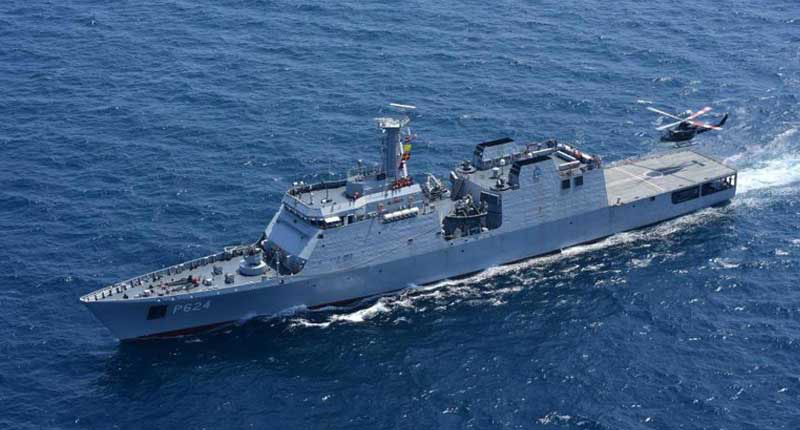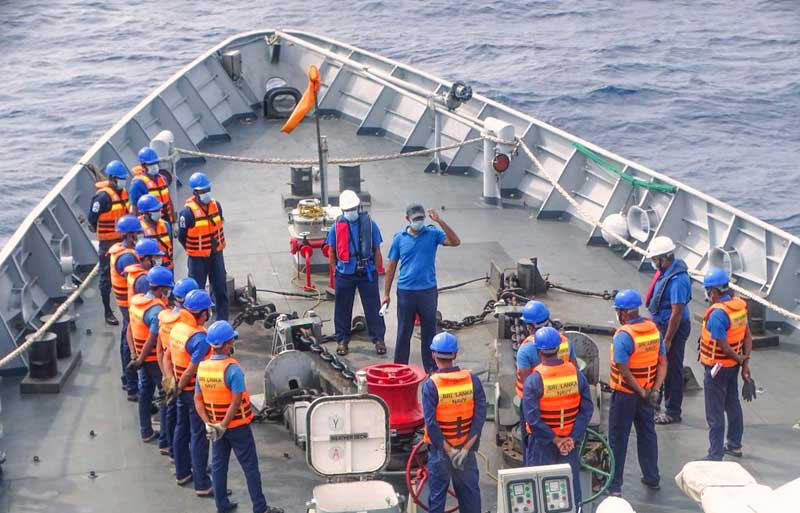SLNS Sindurala: A Tight Ship
June 27, 2021SLNS Sindurala: A Tight Ship
By Dishan Joseph

Sri Lanka is a resplendent island blessed with natural resources. Today we are at a juncture where extra-regional countries desire to have some presence in the Indian Ocean Region. In this background, the projection of our sea power in a geopolitical context sustains our territorial integrity as a nation.
The ocean has become a medium for information, transportation and domination. The Navy has made consistent progress over the past seven decades. The Sri Lanka Navy has been prudently transformed from a ceremoni-al outfit to a deep sea capacity battle-experienced fleet.
The naval fleet has made professional advances in speed and firepower. The first such Fast Gun Boats (Shanghai Class FGB) were given by the People's Republic of China. These two boats were named SLNS Weeraya and SLNS Sooraya. By 1980, the Navy added five more of these Fast Gun Boats. Subsequently, SLNS Samudra Devi was received as a gift from the USSR. The fleet was further strengthened with the Offshore Patrol Vessels (OPV), SLNS Jayasagara and SLNS Sagarawardena. Subsequently, Advanced Offshore Patrol Vessels were inducted into the fleet enhancing the deep sea patrolling capability of the Sri Lanka Navy.
SLNS Sindurala., bearing pennant number P-624, is a formidable Advanced Offshore Patrol Vessel (AOPV). I went on board this vessel to witness its advanced operating systems and to experience the routine life of sailors at sea. The Commanding Officer is Captain A.I.P. de Silva. He said: "We are proud to serve on this vessel. We have a total of 127 staff - 19 officers and 108 sailors. My officers represent the Executive branch, Engineering branch, Electrical branch and the Logistics branch. We also have the a facility to land a helicopter on this vessel. We engage in patrolling and monitoring of our EEZ (Exclusive Economic Zone), and also act as a deterrent against smugglers. Our crew has the capacity to take part in search and rescue operations."
It was time to walk around this fortified superstructure which has a length of 105 metres and a breadth of 13 metres. I was accompanied by the ship's Executive Officer. We made our way through a series of ladders. Ladders on an AOPV are at a steep angle, yet the sailors rapidly go up and down with experience. Our first stop was at the engine room. I was able to witness the German-made engines that sustain the propulsion of this vessel which has a displacement (ship's weight) of 3,318 tonnes. Engineering crews were busy checking an assortment of charts and display units. The clean atmosphere of this engine room must be highly commended. It shows the passion these sailors have for their job. From here we walked through another hatch and reached the reverse osmosis plant — where seawater is taken in and purified to a clean level fit for drinking. The vessel has the capacity to pro-duce 31,000 litres of fresh water in a day. I sampled a glass of this transformed water and it was amazingly pure, a testament to naval innovation.

From here a flight of steps led us to the junior sailors' living quarters. Some young men who were seated on bunk beds engaged in conversation. They told me that they feel very privileged to work on this vessel and happy about the trade skills they were able to master during their basic training. Living and working on a massive naval vessel unites the sailors and their officers into one sailing family. Out at sea being hundreds of miles away from home, they have to depend on each other. Our next stop was at the ship's galley (kitchen). Two chefs were busy making rice and curry. Onboard SLNS Sindurala, there are no open flame burners, instead induction surface cookers are used. Frying is also avoided as it has the risk of hot oil splashing about, hence such items are baked. These culinary innovations high-light how the fleet has advanced in every sphere of daily operations on board. The sailors work three shifts and the chefs have to feed many hungry sailors. Passing the galley we walked into the salon, where the sailors cut each other's hair and trim their beards in accordance with naval regulation. Along this passage, we came across the vessel's Medical Station which has high-tech equipment. If required even small surgeries can be per-formed whilst at sea.
As we climbed down to the next level, a fire response training drill was in progress. An officer explained: "When we are at sea, we have to respond and mitigate a fire, if one suddenly flares up. Our crews are trained to extinguish a fire responding quickly within three minutes of the fire alarm." We were now escorted by the vessel's Chief Electrical Engineer. He showed me the modern panels and displays that monitor and track every inch of wire and cable on this vessel. I was stunned to discover that SLNS Sindurala has 150 km of wiring and 150 km of communication cable. In addition, the vessel has high-tech smoke sensors. Moving forward we came to imposing forecastle of the vessel. This is where the ship's main defence armament, the 37mm gun is positioned. This gun has a maximum range of 8,500 metres and an effective firing range of 4,000 metres. In addition, SLNS Sindurala has additional fire support from an assortment of guns. The ship has two anchors that weigh 1,440 Kg each.
The bridge is the heart of every naval vessel. This is the captain's seat of command from where he directs and guides his crew. There is a seagoing proverb that you can't control the wind, but you can direct the sails. This shows the responsibility on a captain's shoulder. SLNS Sindurala has a modern Integrated Bridge System. This incorporates a network of monitors, radars and displays. From the large windows, the accomplished navigation crew has a clear view of the coruscating blue shades of the ocean. From this vantage point, I was able to observe the RAS drill - Replenishment at Sea. This is a drill that must be done to precision timing by two sailing vessels.
One is the 'delivery' vessel and the other the 'receiving' vessel. The vessels come along-side each other keeping a gap of about 40 metres. Both vessels must maintain the same speed. A Petty Officer casts out a line to the receiving vessel. Once the line was secured the required supplies are dispatched. When replenishment is complete the vessels slowly move apart. The RAS drill is a manifestation of naval training and discipline. This AOPV also carries two small boats (water jets) which are deployed to check suspicious vessels at sea, without putting the large vessel in danger. In addition, the ship has a team of SBS naval commandos.

Climbing down a hatch we entered the Wardroom (officer's mess). The captain and his officers extended an invitation for lunch. Two sailors were busy setting up the table with cutlery and crockery. Once seated, you can't imagine that this lunch session is on board a naval vessel. The atmosphere resembles being seated at a restaurant. Lunch consisted of rice and curry. SLNS Sindurala has a seagoing endur-ance of 15 days (7,000 Nautical Miles) and can carry its dry rations for 90 days. Being an island nation, the Sri Lanka Navy has a significant role in maritime defence. SLNS Sindurala and her dedicated crew will sail forward to uphold the dignity, commitment and courage of the Navy.
Courtesy - www.dailynews.lk